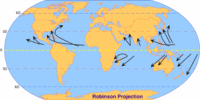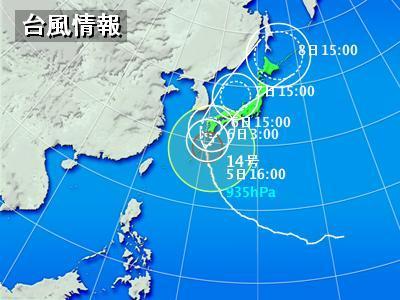:::::::::::::::::::::::::::::::::::::::::::::::::::::::::::::::::::::::::::::::::::::::::::::::::::::
Typhoon, Hurricane, Cyclone
***** Location: Japan, North America, Tropics
***** Season: Mid-Autumn in Japan,
.....................late tropical rainy season
***** Category: Heaven
*****************************
Explanation

"Women Running in a Storm", Isoda Koryūsai (1735–1790)
taifuu 台風 typhoon, Taifun
In Japan, typhoon is a kigo for mid-autumn, mostly September when most of them hit the islands.
In America, these strong winds are called hurricane.
"violent storm, hurricane," from Gk. typhon "whirlwind,"
personified as a giant, father of the winds, perhaps from typhein "to smoke." Or borrowed from Chinese (Cantonese) tai fung "a great wind," from tu "big" + feng "wind;" name given to violent cyclonic storms in the China seas. A third possibility is tufan, a word in Arabic, Persian and Hindi meaning "big cyclonic storm," which may be from the Gk., or from Ar. tafa "to turn round."
source : www.etymonline.com
quote
The Greek word (tuphon) meaning whirlwind, and the Arabic word (tufan) meaning deluge, or (tafa) meaning overflow or walkabout seem to be the origin of typhoon, which the Chinese seem to have adopted and created a new word big wind, or ta feng. In the face of the forces of nature manifesting themselves in typhoons and earthquakes, you may understand the 'modesty' and 'humility' of the Japanese people (of the past) towards the almighty nature.
Susumu Takiguchi
:::::::::::::::::::::::::::::::::::::::::::::::::::::::::::::::::::::::::::::::::::::::::::::::::::::

http://www.physicalgeography.net/fundamentals/images/hurricanepaths.GIF
:::::::::::::::::::::::::::::::::::::::::::::::::::::::::::::::::::::::::::::::::::::::::::::::::::::
"parting the fields" nowaki 野分, のわき
"field-dividing" wind, "field-divider"
kigo for mid-autumn
Usually between the day 210 and 220 after the beginning of spring (risshun). Typhoon, autumn gale or strong windstorm at this time. It stressed the WIND aspect of a typhoon, not the rain.
strong windstorm, autumn storm, nowake 野わけ(のわけ)
.... nowakidatsu 野分だつ(のわきだつ), 野分き立つ
clouds of a windstorm, nowakigumo 野分雲(のわきぐも)
aftermath of a windstorm, nowaki ato 野分跡(のわきあと)
fine weather after a windstorm, nowaki bare 野分晴(のわきばれ)
Living in the rice fields of Western Japan, I have come to see this "parting of the fields" quite often after our autumn typhoons. It hurts to see the ripe ears of rice hang down on the ground to the right and left of a swath of flattened stems.

Nowaki (野分 Nowaki)
is a short Japanese novel by Natsume Sōseki (1867-1916). Written in 1907, the novel was published in the magazine Hototogisu in January. The year 1907 was a turning point in the author’s life when he left his Tokyo University teaching position to write full-time for the daily Asahi Shimbun.
© More in the WIKIPEDIA !
. . . . .
Genji Monogatari : Chapter 28
Nowaki 野分 Typhoon
第二十八帖 野分

. Genji Monogatari 源氏物語 The Tale of Genji .
:::::::::::::::::::::::::::::::::::::::::::::::::::::::::::::::::::::::::::::::::::::::::::::::::::::
:::::::::::::::::::::::::::::::::::::::::::::::::::::::::::::::::::::::::::::::::::::::::::::::::::::
kigo for mid-summer
mizu mimai 水見舞 (みずみまい)
visiting after a water damage
lit. "water visit"
After a typhoon has brought damage in the form of flooding and landslides, it was customary to visit relatives and friends and support them with money and other help.
. SAIJIKI ... HUMANITY - Kigo for Summer
.......................................................................

Hiroshige
歌川広重 -「六十余州名所図会 美作 山伏谷」
*****************************
Worldwide use
Trinidad and Tobago
During the late RAINY SEASON/WET SEASON storm watch, and storm or hurricane warnings are as natural as sunrise and sunset. Such public notices are authorised and issues from the National Agency responsible for Disaster preparedness and management; NEMA
storm watch
in the uncanny calmness
a hazy sunset
hurricane warning
the stray cats
have gone away
the storm having passed on
sunny day
the call of a kis-ka-dee
Gillena 2004
Hurricane relief, storm relief
kigo for the Late wet season
scorching hot day
water tops
the hurricane relief list
Gillena Cox
.............................................................................
North America
During the six-month hurricane season that runs from June 1 through Nov. 30, the center is responsible for alerting people to storms in a vast expanse of two oceans, the Atlantic and eastern Pacific.
- Reference -
*****************************
Things found on the way
. Typhoon legends - taifū 台風 伝説 Taifun Legenden .
. The Wind God, Fuujin 風神 Fujin、Fuu-ten 風天 .
*****************************
HAIKU
September 2005
i gratefully write that my area was not directly affected by hurricane rita.
however, we were close enough to experience the tips of the spiral nebula that was the storm.
all thru the afternoon before landfall and all the next two days, we at the fringes of the 170 mile wide storm were amazed at the spectacle of watching the arms of the storm spiral overhead. sweeping arms of cloud, hazy sunshine, cloud, sunshine .... repeated every hour. ten minutes of sun for every hour of cloud.
the hurricane's approach
spiral fingers
of pink clouds
we just got high winds and nary a drop of rain.
hurricane threat past
rehanging the windchimes
gratefully,
susan delphine delaney MD
:::::::::::::::::::::::::::::::::::::::::::::::::::::::::::::::::::::::::::::::::::::::::::::::::::::

waiting for
mighty strong number fourteen -
katrina on my mind
Then it comes to hit Japan:
Typhoon Nabi 14 September 2005 台風14号
fallen leaves
fallen fruit and
fallen hopes
............................... Green Apples fallen by typhoon 14
............................... Humans Powerless Katrina 2005
Gabi Greve
Our Typhoon Season in Japan, 2007
From 2004
typhoon -
in the folds of my robe
a bee hiding
cleaning the street
with a broom like old Jittoku -
typhoon destruction
some forgotten clouds
hooked to the mountains -
typhoon is over
:::::::::::::::::::::::::::::::::::::::::::::::::::::::::::::::::::::::::::::::::::::::::::::::::::::
in the moonlit night
children swirl on a cold verandah --
China typhoon
yamame winslause, Kenya
August 2009
:::::::::::::::::::::::::::::::::::::::::::::::::::::::::::::::::::::::::::::::::::::::::::::::::::::

© Haiga by Sakuo Nakamura
芦の穂の波に屯ス野分哉
ashi no ho no nami ni tamuro su nowaki kana
this typhoon
is hanging out making waves
in the ears of the reeds . . .
Kobayashi Issa
Tr. Gabi Greve
. . READ : Discussion of the translation.
狂乱の野分ありたき我思ひ
kyooran no nowaki aritaki waga omoi
Ah, that my thoughts
Might have the frenzy
Of this "field-dividing" wind!
Masaoka Shiki
Tr. Blyth
*****************************
Related words
***** WIND in various kigo
***** Wind Chimes (fuurin, Japan)
. Typhoon (Hurricane)
(Backup)
[ . BACK to DARUMA MUSEUM TOP . ]
[ . BACK to WORLDKIGO . TOP . ]
:::::::::::::::::::::::::::::::::::::::::::::::::::::::::::::::::::::::::::::::::::::::::::::::::::::








8 comments:
winter night ~
howling hurricanes
in astral dances ~
Narayanan Raghunathan
This haiku has two kigo.
::::::::::::::::::::::::::::::::::::::::::::::::::::::::::::::::::::::
typhoon seaseon <>
a dragon hovers
over Japan
Gabi Greve, July 2006.
LOOK !!!
::::::::::::::::::::::::::::::::::::::::::::::::::::::::::::::::::::::
.
tpyhoon usagi -
a wild rabbit leaves
its footprints
August 2007, Japan
Gabi Greve
Myanmar Cyclone May 2008
YANGON, Myanmar - Myanmar's Irrawaddy delta remained largely cut off from the rest of the world Tuesday, four days after a cyclone unleashed winds, floods and high tidal waves on the densely populated region, killing nearly 22,000.
State radio reported that more than 41,000 others were missing in the wake of Asia's deadliest storm since 1991.
With the death toll expected to mount and as many as 1 million possibly left homeless, the international community was poised to deliver aid to the military-ruled country, which normally keeps out most foreign officials and restricts their access inside the country.
http://www.msnbc.msn.com/id/24478247/
On 26-27 September 2009, Typhoon Ondoy, internationally known as Typhoon Ketsana, wreacked havoc in The Philippines, most notably in Manila, where more than half the streets were flooded, entire neighbourhoods were swept away, and some 350 people lost their lives. The devastation is enormous, relief operations can scarcely be carried out, and the population is suffering terribly. And yet, the spirit of the Filipino rises even above these things. There is even room for humor.
Typhoon Ondoy
on the poor man's back
his pregnant wife
after the storm
a swimming competition
in a flooded street
sacks of rice
at a typhoon relief center
... a child's hungry eyes
in only six hours
a month's supply of rain
swells the Pasig --
the sticks and planks
of ten small villages
颱風の目つついてをりぬ豫報管
taifuu no me tsutsuite orinu yohookan
poking the eye
of a typhoon
a weather-forecast man
Michio Nakahara 中原道夫
Tr. Fay Aoyagi
http://fayaoyagi.wordpress.com/2010/10/24/todays-haiku-october-24-2010/
神木も倒して隠岐の野分かな
shinboku mo taoshite Oki no nowaki kana
this typhoon
has even blown down the divine tree
at Oki island
Yoshikawa Umeko 吉川梅子
MORE
about divine trees
Kobayashi Issa
月ちらちら野分の月の暑哉
tsuki chira-chira nowaki no tsuki no atsusa kana
moon seen, unseen --
the heat of this
typhoon moon
This hokku is from the eighth month (September) of 1811, when Issa was in the greater Edo area. In Issa's time typhoons, especially strong ones in the eighth month, were called nowaki, literally winds that blow so hard they push right through tall field grass, bending it low. Most typhoons reach Japan from further south in the Pacific or from the East China Sea to the south, so they usually pull a lot of warm, humid air with them as they move north, mixing their warm air with the comparatively cooler air in Japan. The hokku evokes the moon as being affected by the strong, strangely warm wind and by the rapidly streaming clouds that seem to wrap the moon in darkness one moment and the next moment allow it to shine through, partially or fully. Until the typhoon arrived, nights had probably been gradually getting cooler in September, but suddenly it is muggy, and even the moon seems to be a hot, humid, roiling place. The next hokku in Issa's diary calls the flickering moon during the typhoon "strangely/somehow/uncannily/disagreeably hot" (nama-atsui). Perhaps the suddenly changed sky and the moon's changing shapes coming through the wet, churning clouds suggest a hot yet cool cauldron.
The hokku mentions the moon twice. I take the two moons to be intentional, since I think Issa wants to distinguish a weird, uncanny typhoon moon from ordinary moons. This moon feels so strangely hot and without a single stable shape that it almost seems unreal.
Chris Drake
Post a Comment